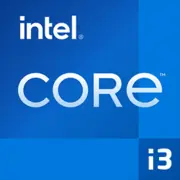Intel Core i3-12300T

Intel Core i3-12300T: Budget Processor for Everyday Tasks and More
Overview and Practical Recommendations for Building PCs in 2025
Key Features: Architecture, Process Technology, and Main Characteristics
The Intel Core i3-12300T processor, released in 2022 as part of the Alder Lake lineup, remains a relevant budget solution even in 2025. Its architecture is based on hybrid technology, but unlike the higher models (i5, i7), it features 4 Performance-cores (P-cores) with Hyper-Threading support (8 threads). The absence of Efficient-cores (E-cores) simplifies the structure but maintains a focus on energy efficiency.
Intel 7 Process Technology (10nm Enhanced SuperFin) provides a balance between performance and thermal output. The base frequency of the P-cores is 2.30 GHz, with turbo boost capabilities up to 4.20 GHz in single-threaded tasks. This makes it one of the fastest i3 processors in its class. The L3 cache size is 12 MB, enhancing responsiveness in applications that require frequent data access.
Key Features:
- Support for PCIe 5.0 (up to 16 lanes) for future upgrades of graphics cards and NVMe drives.
- Integrated Intel UHD Graphics 730 — a basic option for office tasks and 4K video.
- Intel Thread Director and AI optimization technologies for Windows 11.
Compatible Motherboards: Sockets, Chipsets, and Selection Nuances
The processor uses the LGA 1700 socket, which is supported by chipset series 600 and 700 (H610, B660, H670, Z690, B760). For the i3-12300T, motherboards based on B660/B760 are optimal — they offer PCIe 4.0, memory overclocking, and a sufficient number of USB/SATA ports without excessive features.
Examples of 2025 Models:
- ASUS Prime B760M-A D4 ($110-130): supports DDR4, 2 M.2 slots, reliable VRM system.
- Gigabyte B760 DS3H AX DDR5 ($140-160): Wi-Fi 6, DDR5, ideal for upgrades.
Tip: If you do not plan to move to DDR5, choose DDR4 versions — memory is cheaper, and the performance difference for the i3 is minimal.
Supported Memory Types: DDR4 vs. DDR5
The processor is compatible with DDR4-3200 and DDR5-4800, but the specific standard depends on the motherboard. For a budget build in 2025, DDR4 remains the preferred option:
- 16 GB DDR4-3200 (2x8 GB) — starting at $40.
- 16 GB DDR5-4800 — starting at $60 (prices have decreased by 20% since 2023).
Important: DDR5 offers benefits in bandwidth-sensitive tasks (e.g., rendering), but for office work and multimedia, DDR4 is sufficient.
Power Supply Recommendations
With a TDP of 35W, the i3-12300T is one of the "coolest" processors. However, considering the graphics card and other components, the minimum power supply wattage should be 400W.
Examples:
- be quiet! System Power 10 450W ($50): quiet, with 80+ Bronze certification.
- Corsair CX550M ($65): modular design, reliability.
Tip: If you plan to install a discrete graphics card (e.g., NVIDIA GTX 1660), choose a power supply of at least 500W.
Pros and Cons of Intel Core i3-12300T
Pros:
- Energy efficiency: ideal for compact PCs and systems with passive cooling.
- High single-thread performance (Geekbench 6 Single Core — 1906).
- PCIe 5.0 and Wi-Fi 6 support (through motherboards).
Cons:
- No E-cores — multi-thread performance is weaker compared to Ryzen 3 7300G (Geekbench 6 Multi Core — 6487 vs. 7100 for AMD).
- Integrated graphics are not suitable for modern gaming.
- Limited overclocking (turbo mode depends on temperature).
Usage Scenarios
1. Office and Study: Fast performance with browsers, documents, and video conferencing.
2. Multimedia: Streaming 4K video, editing in DaVinci Resolve (with a discrete GPU).
3. Light Gaming: CS2, Dota 2 on low settings (with a graphics card like NVIDIA GTX 1650).
4. Home Server/NAS: Low power consumption and virtualization support.
Real-life Example: A Reddit user built a media center using i3-12300T, ASRock H610M-ITX motherboard, and 16 GB of DDR4. The system consumes 25W at idle.
Comparison with Competitors
AMD Ryzen 3 7300G (Zen 4):
- Pros: More powerful Radeon graphics, better multi-threading (~10%).
- Cons: Higher price ($160 vs. $130 for i3), no PCIe 5.0.
Intel Core i5-12400T:
- Pros: 6 cores, better for multitasking.
- Cons: 30% more expensive ($180), TDP 35W.
Conclusion: The i3-12300T excels in price/performance efficiency but falls short in multi-threaded scenarios.
Practical Assembly Tips
1. Cooling: The stock cooler is sufficient, but for a quieter operation, consider the DeepCool AK400 ($25).
2. Storage: Ensure an NVMe SSD (e.g., Kingston NV2 1TB — $60).
3. Case: Mini-ITX (Fractal Design Node 304) or compact Micro-ATX.
4. Upgrade: Add a graphics card if gaming or video editing is needed.
Final Conclusion: Who is i3-12300T Suitable For?
This processor is an excellent choice for:
- Budget PCs: Office, studies, browsing.
- Media Centers: 4K video, streaming.
- Energy-efficient Systems: NAS, home servers.
2025 Price: $120-130 (new), making it one of the best in terms of price/performance. If maximum performance is not required, the i3-12300T is a sensible save without compromising on basic tasks.
Basic
CPU Specifications
Memory Specifications
GPU Specifications
Miscellaneous
Benchmarks
Compared to Other CPU
Share in social media
Or Link To Us
<a href="https://cputronic.com/en/cpu/intel-core-i3-12300t" target="_blank">Intel Core i3-12300T</a>